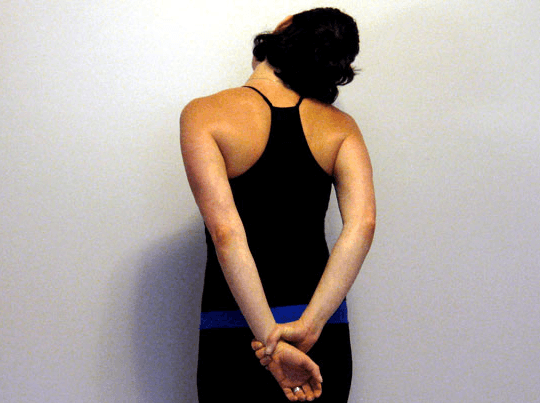There’s nothing quite as satisfying as getting a good shoulder pop or crack from a chiropractor. That feeling of release and relief as tension melts away is hard to beat. But what if you can’t make it in for an appointment? Whether you’re short on time, want to save some money, or just prefer the DIY approach, there are ways you can pop your own shoulder at home like the pros. In this guide, we’ll walk through several chiropractor-approved techniques for self-adjusting your shoulder joints.

Understanding Shoulder Pain and Stiffness
Before we dive into the how-to, it’s important to understand what might be causing your shoulder pain and stiffness in the first place. Here are some common culprits:
- Muscle Tension: Whether it’s from poor posture, repetitive motions, or just good old-fashioned stress, muscle tension in your shoulders, neck, and upper back can lead to stiffness, knots, and discomfort.
- Joint Restriction: If the joints in your shoulder (like the glenohumeral joint or the acromioclavicular joint) aren’t moving as freely as they should, it can cause pain, popping sensations, and a limited range of motion.
- Injury: Strains, sprains, or other injuries to the muscles, tendons, or ligaments around your shoulder (such as the rotator cuff) can result in pain, inflammation, and stiffness, especially if left untreated.
- Arthritis: Conditions like osteoarthritis or rheumatoid arthritis can cause inflammation, joint degeneration, and the formation of bone spurs in the shoulder joint, leading to chronic pain and stiffness over time.
- Bursitis: Inflammation of the bursa (small fluid-filled sacs that cushion the joints) in your shoulder can cause pain, swelling, and restricted movement.
- Pinched Nerve: If a nerve in your shoulder or neck area becomes compressed or pinched, it can radiate pain, numbness, or tingling down your arm and into your shoulder.
Identifying the root cause of your shoulder discomfort can help you determine the best course of action. In some cases, popping your shoulder may provide temporary relief, but for more serious or chronic issues, it’s always a good idea to consult with a healthcare professional.
How to Pop Your Shoulder By Yourself
Ready to give it a try? Here are some common techniques chiropractors use to pop the shoulder joint that you can attempt at home:
Doorway Shoulder Stretch
- Stand sideways in an open doorway
- Raise your affected arm and place your forearm flat against the door frame
- Gently lean your body forward, allowing your shoulder to open up and stretch
- You may feel a pop or release as your shoulder joint opens up
Weighted Shoulder Pull
- Holding a lightweight (3-5 lbs), raise your affected arm straight out to the side
- Keeping your arm straight, slowly pull the weight across your body toward the opposite hip
- Go slowly and stop if you feel any sharp pains
- You may hear a pop as the shoulder joint releases tension
Seated Shoulder Traction
- Sitting upright, interlace your fingers behind your lower back
- Keeping your shoulders pulled back, slowly raise your arms up and back to open up the shoulder joint
- You may feel a pop or release of tension in your upper back/shoulder area
Foam Roller Shoulder Release
- Lie on your back and position a foam roller horizontally under your shoulder blades
- Keeping your head supported, slowly roll your body over the foam roller from your mid-back up toward your shoulders
- Apply gentle pressure to any tight/knotted areas until you feel a release
- This can help relieve muscle tension contributing to shoulder tightness
Wall Shoulder Stretch
- Stand facing a wall with your affected arm raised and forearm against the wall
- Take a small step back, keeping your palm flat on the wall
- Gently lean your body toward the wall until you feel a stretch in your shoulder/chest
- You may feel a pop as your shoulder joint opens up
Always move slowly and gently with these techniques. Never force the joint to pop, as this can potentially cause injury. If you don’t feel or hear a release after a few careful attempts, stop and try again later or another day.
Chiropractor Tips for Popping Shoulders Safely
While popping your own shoulder can provide relief, it’s important to take some precautions to avoid injury. Here are some professional tips from chiropractors:
- Go Slow Never try to force or aggressively pop the shoulder joint. Use slow, controlled movements and gentle pressure to coax the joint into releasing naturally.
- Listen to Your Body Stop immediately if you experience sharp, shooting pains or feel like something isn’t quite right. Pushing through discomfort can lead to serious injury.
- Taking deep breaths and staying relaxed can help your muscles release tension more easily. Don’t hold your breath while attempting adjustments.
- Use Support For certain techniques, you may need to lean against a wall or door frame for support and leverage. Make sure the surface is stable to avoid falls.
- Apply Heat First Using a heating pad or taking a warm shower beforehand can help loosen up the muscles and joints, making it easier to pop the shoulder.
- Stay Hydrated Proper hydration keeps your muscles, tendons, and joints lubricated and functioning at their best. Dehydration can increase stiffness and tension.
- Know Your Limits If you have any concerning symptoms or the shoulder just won’t pop, don’t force it. See a professional for evaluation and treatment.
Be Consistent Performing gentle shoulder mobility exercises daily can help maintain healthy joint function and reduce the need for more aggressive self-adjustments.
When to Try Popping Your Own Shoulder
Attempting to self-adjust your shoulder is generally safe if you’re experiencing minor, temporary discomfort related to:
- Muscle tightness or knots in the shoulders/upper back
- Joint stiffness or restricted mobility
- Mild shoulder pain without swelling or bruising
- “Cracky” sensations when moving the shoulder
Self-adjustments can sometimes provide relief for these types of issues by releasing tension, realigning the joint, and restoring proper movement patterns.
However, you’ll want to avoid popping your own shoulder if you have any of the following symptoms, as they could indicate a more serious injury that requires medical evaluation:
- Severe, persistent shoulder pain
- Visible deformity or abnormal shoulder positioning
- Inability to move the shoulder at all
- Swelling, bruising, or warmth around the joint
- Numbness, tingling, or weakness in the arm/hand
- Recent trauma to the shoulder area like a fall or collision
If you experience any of those red flags, it’s best to see a doctor, physical therapist or chiropractor for proper diagnosis and treatment. Attempting to self-adjust under those circumstances could potentially worsen the injury or cause further damage.
How to Pop Your Shoulder with Help
If you would like someone else to help you relocate your shoulder, do not take it against other people if they are not too happy or eager to help you. They likely want to help eliminate the pain and discomfort but fear they may hurt you more because they do not know.
If in case you do find someone willing to help you, here is the process that you have to follow:
- Lay down flat on your back on a flat surface.
- Place the injured arm away from you and ensure it is at a 90-degree angle.
- The person who will help you should hold on to your arm or hand and slowly pull on it. The pull should be slow and steady. If the pull is sudden, then this may end up hurting your arm even more.
- You would know if popping the shoulder back is successful if you hear a particular sound, and the shoulder will feel like it has gotten back into position, although it may be a bit sore.
- When the shoulder returns to its normal position, you will feel that the pain will lessen immensely.
Remember that the shoulder will still be a bit unstable, and you need to have your shoulder checked by a medical professional, so you need to keep your arm in a sling.

When to Seek Professional Help?
While self-adjustment techniques can be effective for minor shoulder discomfort, there are certain situations where it’s best to seek professional help from a chiropractor, physical therapist, orthopedist, or other healthcare provider:
- Severe or Persistent Pain: If your shoulder pain is severe, persistent (lasting more than a week or two), or accompanied by other concerning symptoms like numbness, tingling, weakness, or swelling, it’s important to get it evaluated by a professional.
- Limited Range of Motion: If your shoulder mobility is significantly limited, even after self-adjustment attempts, it could be a sign of a more serious issue like a torn rotator cuff or frozen shoulder that requires professional treatment.
- Injury or Trauma: If your shoulder pain is the result of a recent injury or trauma, such as a fall, car accident, or sports-related impact, it’s best to seek medical attention to rule out any serious damage or underlying conditions like a fracture or dislocation.
- Chronic Conditions: If you have a chronic condition like arthritis, fibromyalgia, or a previous shoulder injury, self-adjustment may not be sufficient or appropriate for managing your symptoms long-term. A healthcare professional can develop a more comprehensive treatment plan tailored to your specific needs.
- Lack of Improvement: If you’ve been consistently trying self-adjustment techniques without any noticeable improvement in your shoulder discomfort after a few weeks, it’s time to seek professional guidance to identify and address the underlying cause.
- Radiating Pain or Neurological Symptoms: If your shoulder pain is accompanied by radiating pain, numbness, or tingling down your arm or into your hand, it could be a sign of a pinched nerve or other neurological issue that requires medical attention.
Maintaining Shoulder Health Long-Term
While popping your own shoulder can provide satisfying relief for minor aches and stiffness, it’s not a complete solution for long-term shoulder health. Think of self-adjustments as a temporary fix, not a cure-all.
For lasting results and to prevent future issues, you’ll want to adopt some healthy habits like:
- Performing gentle shoulder mobility exercises daily
- Applying heat or cold therapy as needed
- Maintaining proper posture, especially if you work at a desk
- Strengthening shoulder muscles through targeted exercises
- Getting regular massage therapy or chiropractic adjustments
- Modifying activities that aggravate your shoulder
- Using ergonomic support for your workstation
- Taking frequent stretch breaks if you have a sedentary job
With some patience and commitment to caring for this complex joint, you can keep your shoulders feeling their best and reduce the need for frequent self-cracking or popping.
But for those times when you just need an instant release? Go ahead and try one of the techniques above. That satisfying pop can hit the spot. Just be sure to listen to your body and use common sense to avoid injury.
Your shoulders will thank you for giving them the care and attention they deserve!






